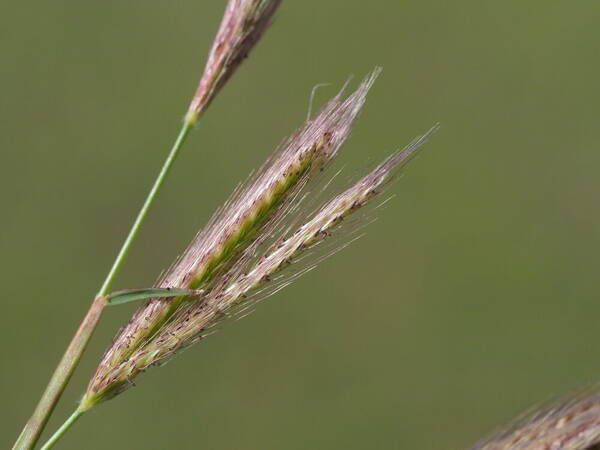Info
Subfamily: Chloridoideae
Genus etymology: Chloris = Goddess of vegetation [Greek], generally used to refer to a pale green color
Species etymology: virgata = "broom possessing" [Latin] refering to the inflorescnece branches being held erect
Photosynthetic type: C4 (warm season)
Nativity: naturalized - accidental
First recorded in Hawaiʻi: 1903
Map


Inflorescence




Plant

Habit



Spikelets




Landscape

Description
Plants annual; usually tufted, occasionally stoloniferous. Culms 10-100+ cm. Sheaths usually glabrous; ligules to 4 mm, erose or ciliate; blades to 30 cm long, to 15 mm wide, basal hairs to 4 mm, otherwise usually glabrous, occasionally pilose. Panicles digitate, with 4-20, evidently distinct branches; branches 5-10 cm, erect to ascending, averaging 10 spikelets per cm. Spikelets strongly imbricate, with 1 bisexual and 1(2) sterile floret(s). Lower glumes 1.5-2.5 mm; upper glumes 2.5-4.3 mm; lowest lemmas 2.5-4.2 mm, keels usually prominently gibbous, glabrous, or conspicuously pilose, sides not grooved, margins glabrous, scabrous or pilose basally, with conspicuously longer hairs distally, hairs longer than 1.5 mm, lemma apices not conspicuously bilobed, awned, awns 2.5-15 mm; second florets 1.4-2.9 mm long, 0.4-0.8 mm wide, somewhat widened distally, not inflated, bilobed, lobes less than 1/5 as long as the lemmas, awned from the sinuses, awns 3-9.5 mm; third florets greatly reduced, unawned and shorter than the subtending rachilla segment or absent but the rachilla segment present. Caryopses 1.5-2 mm long, about 0.5 mm wide, elliptic. 2n = 20, 26, 30, 40.
(Description source: Barkworth, M.E., Capels, K.M., Long, S. & Piep, M.B. (eds.) 2003. Flora of North America, north of Mexico. Volume 25. Magnoliophyta: Commelinidae (in part): Poaceae, Part 2. Oxford University Press, New York. 783 pp. http://floranorthamerica.org/Chloris_virgata )
Annuals; culms erect or geniculately ascending, up to 10 dm tall, occasionally rooting at lower nodes. Basal sheaths strongly keeled and often flabellate, glabrous; ligule inconspicuous, membranous, ca. 0.5 mm long; blades flat, 10-30 cm long, 2-6 mm wide, tapering at apex, upper surface scabrous, lower surface glabrous. Inflorescences of 4-12 digitate, erect to spreading, white to yellowish brown, feathery spikes 2-10 cm long, axils silky villous; spikelets crowded, (2)3-flowered; first glume 1.5-2.5 mm long, second glume 2.5- 4.5 mm long, apex + with a short awnpoint; first lemma obliquely obovate in side view, 2.5-4 mm long, margins and keel ciliate, apex with a crown of hairs 1.5-4 mm long, awn 5-15 mm long, callus rounded, pilose; palea lanceolate, ca. 0.3 mm long, 2- nerved, apical margin ciliate; second lemma slightly projecting from the side of the fertile lemma, oblong, 2-2.5 mm long, glabrous, with an awn 5-12 mm long; apical lemma an awnless clavate scale 0.5-1.2 mm long. Caryopsis golden, cylindrical, 1.5-2 mm long. [2n = 14, 20, 26, 30, 36.]
(Description source: O’Connor, P.J. 1990. Poaceae, pp. 1481–1604. In: Wagner W.L., Herbst D.R. & Sohmer S.H. (eds.)., Manual of the flowering plant of Hawaiʻi. Vol. 2. University of Hawaii Press & Bishop Museum Press, Honolulu )